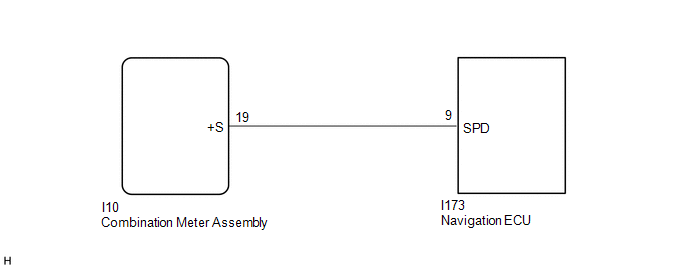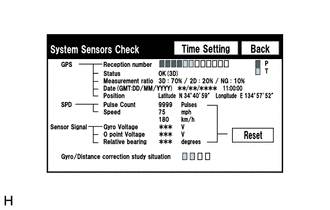Lexus NX: Speed Signal Malfunction (B15C2)
DESCRIPTION
The navigation ECU receives a vehicle speed signal from the combination meter assembly and information from the navigation antenna, and then adjusts the vehicle position on the map.
The navigation ECU stores this DTC when the difference between the speed information that the navigation antenna assembly receives and the SPD pulse received from the combination meter assembly becomes large.
HINT:
- A voltage of 12 V or 5 V is output from each ECU and then input to the combination meter assembly. The signal is changed to a pulse signal at the transistor in the combination meter assembly. Each ECU controls the respective systems based on the pulse signal.
- If a short occurs in any of the ECUs or in the wire harness connected to an ECU, all systems in the diagram below will not operate normally.
| DTC No. | Detection Item | DTC Detection Condition | Trouble Area |
|---|---|---|---|
| B15C2 | Speed Signal Malfunction | A difference between the GPS speed and SPD pulse is detected |
|
WIRING DIAGRAM

CAUTION / NOTICE / HINT
NOTICE:
When replacing the radio receiver assembly or navigation ECU, always replace it with a new one.
If a radio receiver assembly or navigation ECU which was installed to another vehicle is used, the following may occur:
- A communication malfunction DTC may be stored.
- The radio receiver assembly or navigation ECU may not operate normally.
HINT:
Depending on the parts that are replaced during vehicle inspection or maintenance, performing initialization, registration or calibration may be needed. Refer to Precaution for Navigation System.
Click here .gif)
PROCEDURE
| 1. | CHECK DTC |
(a) Clear the DTCs.
Click here .gif)
.gif)
.gif)
(b) Recheck for DTCs and check that no DTCs are output.
Click here .gif)
.gif)
.gif)
OK:
No DTCs are output.
| OK | .gif) | USE SIMULATION METHOD TO CHECK |
|
| 2. | CHECK VEHICLE SENSOR (OPERATION CHECK) |
| (a) Enter the "System Sensors Check" screen. Refer to Check GPS & Vehicle Sensors in Operation Check. Click here |
|
(b) While driving the vehicle, compare the "Speed" indicator to the reading on the speedometer. Check if these readings are almost equal.
HINT:
The combination meter assembly receives the vehicle speed signal from the skid control ECU via CAN communication. Therefore, perform the following inspection referring to values in the Data List of the skid control ECU because it is the source of the vehicle speed signal.
OK:
Vehicle speed displayed on the "System Sensors Check" screen is almost the same as the actual vehicle speed measured using the Techstream.
Click here .gif)
| OK | .gif) | GO TO STEP 5 |
|
| 3. | CHECK COMBINATION METER ASSEMBLY (OUTPUT WAVEFORM) |
| (a) Check the output waveform. (1) Remove the combination meter assembly with the connector(s) still connected. Click here (2) Connect an oscilloscope to terminal I10-19 (+S) and body ground. (3) Turn the power switch on (IG). (4) Turn a wheel slowly. (5) Check the signal waveform according to the condition(s) in the table below.
OK: The waveform is similar to that shown in the illustration. HINT: When the system is functioning normally, one wheel revolution generates 4 pulses. As the vehicle speed increases, the width indicated by A in the illustration narrows. |
|
| NG | .gif) | GO TO METER / GAUGE SYSTEM |
|
| 4. | CHECK HARNESS AND CONNECTOR (NAVIGATION ECU - COMBINATION METER ASSEMBLY) |
(a) Disconnect the I173 navigation ECU connector.
(b) Disconnect the I10 combination meter assembly connector.
(c) Measure the resistance according to the value(s) in the table below.
Standard Resistance:
| Tester Connection | Condition | Specified Condition |
|---|---|---|
| I173-9 (SPD) - I10-19 (+S) | Always | Below 1 Ω |
| I173-9 (SPD) - Body ground | Always | 10 kΩ or higher |
| NG | .gif) | REPAIR OR REPLACE HARNESS OR CONNECTOR |
|
| 5. | REPLACE NAVIGATION ECU |
(a) Replace the navigation ECU with a new one.
Click here .gif)
|
| 6. | CHECK DTC |
(a) Clear the DTCs.
Click here .gif)
.gif)
.gif)
(b) Recheck for DTCs and check that no DTCs are output.
Click here .gif)
.gif)
.gif)
OK:
No DTCs are output.
| OK | .gif) | END (NAVIGATION ECU IS DEFECTIVE) |
| NG | .gif) | REPLACE RADIO RECEIVER ASSEMBLY |

.gif)

.png)
